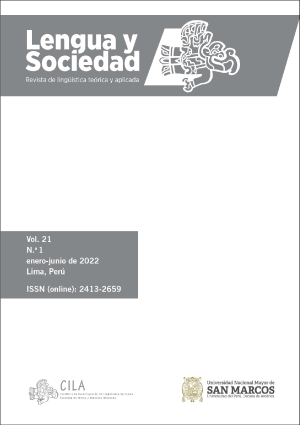Brief acoustic approach of nasal consonants of nomatsigenga with special attention to the velar nasal /ŋ/
DOI:
https://doi.org/10.15381/lengsoc.v21i1.22450Keywords:
Velar nasal, antiformant, spectrum, narrow-band FFT, cepstrumAbstract
This study presents a brief acoustic approach to the nasal consonants of the Nomatsigenga language with special emphasis on the velar nasal. The analysis aims to document the acoustic properties of the nasals in Nomatsigenga and, at the same time, to show that there are features of this class of sounds -especially the velar nasal- in the language that have been little investigated. One of these features is the presence of an antiformant, which is located from two spectral plots: narrow band FFT (Fast Fourier Transform) and cepstrum. From this finding, it could be concluded that the first antiformant for the nomatsigenga nasal phonemes is located approximately around 830 Hz in the labial nasal /m/, between 1500 Hz and 1800 Hz in the alveolar nasal /n/ and, in the case of the velar nasal /ŋ/, it could be determined that the first antiformant is located approximately at the frequency of 3670 Hz in females and 3470 Hz in males. Finally, the range of the palatalized alveolar nasal allophone [nj] is approximately 3300 to 3600 Hz.
References
Apolinario, B. (2020). Acento nominal en nomatsigenga (arawak) [Tesis de licenciatura, Universidad Nacional Mayor de San Marcos]. Cybertesis. https://hdl.handle.net/20.500.12672/14202
Castillo, A. (2020). Irrealis en nomatsigenga (kampa-arawak). [Tesis de maestría, Universidad de Sonora]. Biblioteca Digital Curt Nimuendajú. http://etnolinguistica.wikidot.com/tese:castillo-2020
Elías-Ulloa, J. (2011). Una documentación acústica de la lengua shipibo-conibo (pano). (Con un bosquejo fonológico). Fondo editorial PUCP.
Halle, M., Vaux, B. y Wolfe, A. (2000). On Feature Spreading and the Representation of Place of Articulation. Linguistic Inquiry, 31(3), 387-444. https://www.jstor.org/stable/4179113
Heitzman, A. (1975). Correspondencias entre ciertos grupos de fonemas en varios dialectos campa. En R. Avales de Mato y R. Ravines (Eds.), Lingüística e indigenismo moderno de América. Actas y Memorias del XXXIX CIA (Vol. 5, pp. 165-179). IEP. https://repositorio.iep.org.pe/handle/IEP/528
Instituto Nacional de Estadística e Informática. (2018). Directorio de comunidades Nativas y Campesinas (Tomo I). https://www.inei.gob.pe/media/MenuRecursivo/publicaciones_digitales/Est/Lib1597/TOMO_01.pdf
Jimenez, J. (2018). Los sonidos de la lengua arabela: Bosquejo fonológico. [Tesis de Licenciatura, Universidad Nacional Mayor de San Marcos]. Cybertesis. https://hdl.handle.net/20.500.12672/8177
Johnson, K. (2012). Acoustic and Auditory Phonetics (3.a ed.). Wiley-Blackwell.
Ladefoged, P. y Maddieson, I. (1996). The sounds of the World’s Languages. Blackwell Publishers.
Lawrence, A. (2014). Reconstruction of Proto-Kampa Verbal Morphology. En K. Carpenter, O. David, F. Lionnet, Ch. Sheil, T. Stark y V. Wauters (Eds.), Proceedings of the 38th Annual Meetings of the Berkeley Linguistics Society. Linguistic Society of America. http://dx.doi.org/10.3765/bls.v38i0.3334
Maddieson, I. (1984). Patterns of sounds. Cambridge University Press.
Martínez, E. (1998). Análisis espectrográfico de los sonidos del habla. Editorial Ariel.
Martínez, E. y Fernández, A. (2013). Manual de fonética española. Articulaciones y sonidos del español (2.a ed.). Editorial Planeta.
Michael, L. (2011). La reconstrucción y la clasificación interna de la rama Kampa de la familia Arawak. In CILLA V.
Muñoz, R. (2018). Drawn textgrid (Version 3.0.) [Praat plug-in]. https://github.com/rolandomunoz/plugin_draw_textgrid
Rocha, R. (2020). Análisis fonológico de las consonantes velarizadas en Shipibo: Selectividad y marcadez en la relación consonante-vocal [Tesis de maestría, Universidad Nacional Mayor de San Marcos]. Cybertesis. https://hdl.handle.net/20.500.12672/11843
Shaver, H. (1996). Diccionario nomatsiguenga-castellano, castellano-nomatsiguenga (Serie Lingüística Peruana 41). Instituto Lingüístico de Verano.
Talancha, J. (2010). Poder y Solidaridad: las formas lingüísticas de tratamiento en hablantes nomatsiguenga. [Tesis de licenciatura, Universidad Nacional Mayor de San Marcos]. Cybertesis. https://hdl.handle.net/20.500.12672/1232
Vennemann, T. y Ladefoged, P. (1973). Phonetic features and phonological feautures. Lingua, 32(1-2), 61-74. https://doi.org/10.1016/0024-3841(73)90004-1
Valqui, J., Almeida, C., Haag, F., Bravo, C., Pastor, M. (2011). Labialización en nomatsiguenga. Lengua y Sociedad, 11(1), 121-131. https://doi.org/10.15381/lengsoc.v11i1.22661
Wise, M. (1975). Social roles, plot roles, and focal roles in a Nomatsiguenga Campa myth. En R. Avales de Mato y R. Ravines (Eds.), Lingüística e indigenismo moderno de América. Actas y Memorias del XXXIX CIA (Vol. 5, pp. 125-152). IEP. https://repositorio.iep.org.pe/handle/IEP/528
Downloads
Published
Issue
Section
License
Copyright (c) 2022 Jorge Martín Talancha de la Cruz

This work is licensed under a Creative Commons Attribution 4.0 International License.
AUTHORS RETAIN THEIR RIGHTS
a. Authors retain their trade mark rights and patent, and also on any process or procedure described in the article.
b. Authors can submit to the journal Lengua y Sociedad, papers disseminated as pre-print in repositories. This should be made known in the cover letter.
c. Authors retain their right to share, copy, distribute, perform and publicly communicate their article (eg, to place their article in an institutional repository or publish it in a book), with an acknowledgment of its initial publication in the journal Lengua y Sociedad.
d. Authors retain theirs right to make a subsequent publication of their work, to use the article or any part thereof (eg a compilation of his papers, lecture notes, thesis, or a book), always indicating its initial publication in the journal Lengua y Sociedad (the originator of the work, journal, volume, number and date).






